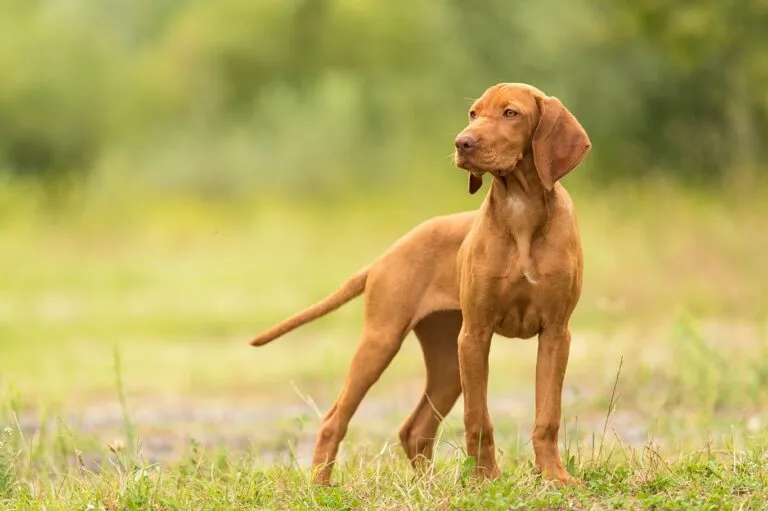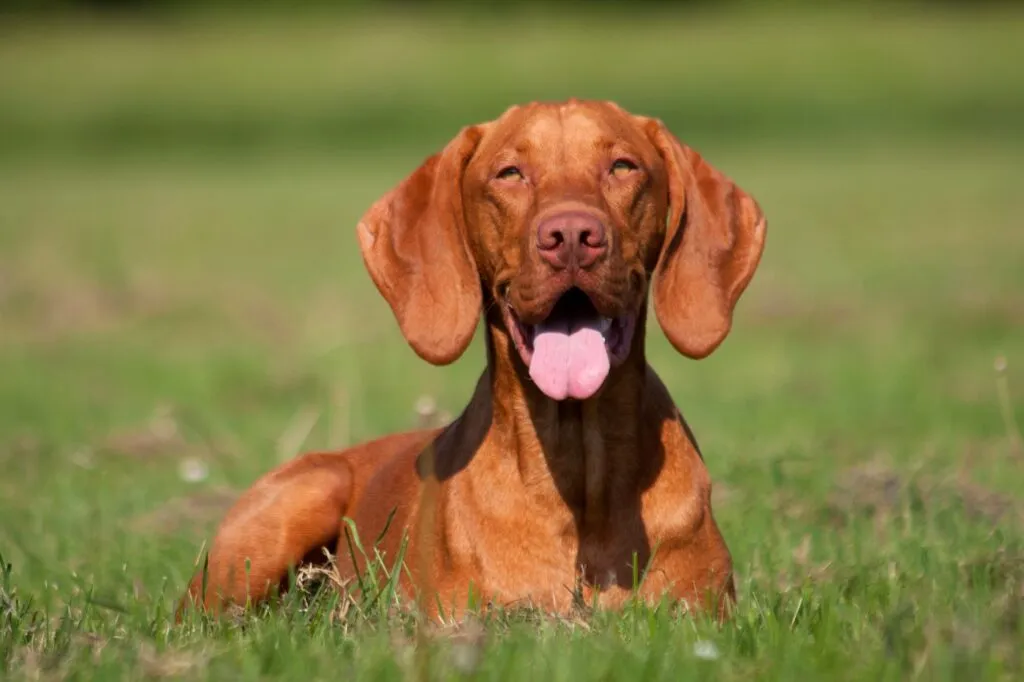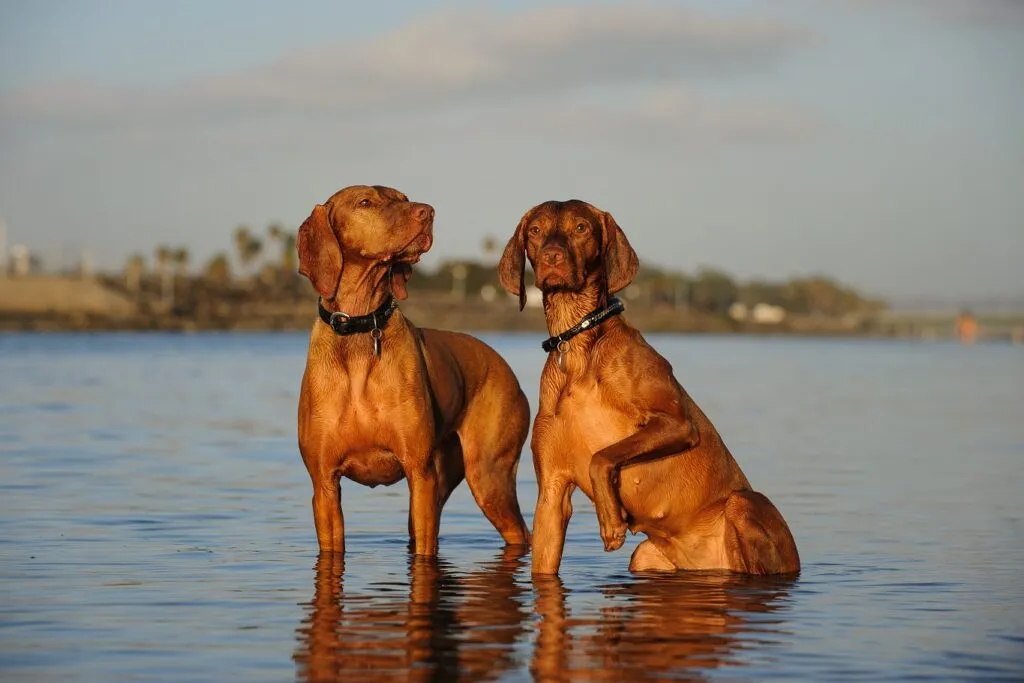Medium Size Poodle
The Magyar Vizsla is a hidden gem among hunters. It’s not only easy to train and smart but also a versatile and enduring companion for hunting and dog sports.

© SasaStock / stock.adobe.com
The Magyar Vizsla is a loyal hunting dog from Hungary.
Enthusiasts of the breed rave that the short-haired Hungarian Pointing Dog looks “like a statue”. Its muscular, harmonious build also resembles its cousins, such as the German Shorthaired Pointer and French pointing dogs.
Males reach a shoulder height of 58 to 64cm, while females are no taller than 60cm. They weigh between 18 and nearly 30kg.
The Magyar Vizsla’s rod extends to the hock and is slightly curved. In some places, owners shorten the rod by a quarter; however, this is now banned in most countries.
The skin should be wrinkle-free according to the standard, with a slightly furrowed forehead. The short, dense top coat without undercoat feels harsh and carries the characteristic sandy-yellow colour of the breed. This colour is uniform and should not contain red or brown tones.
White markings on the toes and a spot of no more than 5cm on the chest are allowed according to the standard.
“Magyar Vizsla” simply means “Hungarian Pointing Dog” in Hungarian. This can also refer to the Wire-Haired Hungarian Pointing Dog. This is not a variant of the Short-Haired Hungarian Pointing Dog but a separate breed.
It was created by crossing the Short-Haired Hungarian Pointing Dog with the German Wirehaired Pointer. The wire-haired Hungarian has been recognised by the FCI since 1956. Apart from the length of the fur and a slightly more robust build, it has the same breed characteristics as the short-haired Magyar Vizsla. However, it is very rare to find.
A well-socialised Magyar Vizsla is a real golden treasure: The breed is friendly and social towards both humans and animals.
When given enough activity, the Hungarian Pointing Dog is balanced at home. Overall, it is a lively dog that likes to be everywhere. Despite its great self-confidence, it is sensitive and attuned to the mood of its pack.
Speaking of the pack: these dogs highly value being with their human family and dislike being alone. It’s essential to train them to be alone from a young puppy age. However, this dog tends to get bored quickly and will find its own activities if left alone for long periods.
Since the Vizsla bonds closely with its carer and is eager to please, it’s easy to train. Excessive harshness is misdirected with this sensitive dog and can damage your trust. Loving consistency is key to having a well-behaved Magyar Vizsla.
While it is keen to learn and follow commands, it is not ideal for novices. Its sensitivity and strong work ethic require tact and know-how from the handler. Socialising and training the puppy, as with all breeds, is crucial.
Many Vizsla owners say their dog has a particularly good memory, both for good and bad experiences. Pay special attention to training recall if you intend to walk your Hungarian Pointing Dog without a lead.
Attend a puppy course where your dog can meet other dogs of various sizes and personalities.
Did you know: This breed is a late bloomer, maturing at three to sometimes even four years old.
 © pfotastisch / stock.adobe.com
© pfotastisch / stock.adobe.com
The Magyar Vizsla is an active breed that requires plenty of exercise to stay balanced. You should plan for at least 2.5 to 3 hours of exercise daily. Without physical and mental stimulation, the Vizsla quickly feels underchallenged.
Primarily, the Magyar Vizsla is a hunting dog. It has an excellent sense of smell, good pointing abilities, and even retrieves from water. It is highly enduring and fast.
Beyond hunting, there are many ways to keep a Vizsla entertained. With proper training, senior dogs can accompany you while cycling or jogging.
This versatile dog also enjoys tasks that require brain or nose work. Many Magyar Vizslas are enthusiastic about training as rescue dogs, including water rescue. While some puppies or young dogs might be cautious around water, most adult Magyar Vizslas love it.
Given the close cooperation with their human, agility or obedience are also great options. Find out what activities bring you and your Vizsla the most delight.
Buying a Magyar Vizsla from a reputable breeder means you are likely getting a robust and healthy dog. Unfortunately, this doesn’t apply to all individuals. Due to regional breeding with a small gene pool, some lines have a genetic predisposition to various illnesses.
These include hip dysplasia, certain tumours, epilepsy, and the skin condition sebadenitis, characterised by inflamed sebaceous glands, hair loss, and intense itching.
A reputable breeder selects breeding dogs based on health to minimise these risks. A healthy Magyar Vizsla usually lives between 12 and 15 years.
Maintain your dog’s athletic figure by feeding it high-quality food in moderation. Opt for a grain-free diet with a high meat content.
Follow the feeding guidelines from the manufacturer concerning the amount. For dry food, measure out the daily ration in the morning and divide it into several portions throughout the day.
Feed a puppy four times a day initially, while an adult Hungarian Pointing Dog requires two meals. After feeding, allow it time for a digestive nap to prevent dangerous gastric torsion.
Beef rawhide bones or dried tripe are excellent chews that will keep your dog occupied for a long time. Ensure your Vizsla always has access to fresh water.
The short fur of the Magyar Vizsla has no undercoat and requires no special care. However, get your puppy used to regular brushing early on. This strengthens your bond and reduces the hair your dog sheds during shedding seasons.
Has your Vizsla gotten dirty in the forest or field? No problem: in most cases, the dirt can be easily brushed out once it’s dried. Bathe your dog only when absolutely necessary using a mild dog shampoo.
 © everydoghasastory / stock.adobe.com
© everydoghasastory / stock.adobe.com
Regularly check your Magyar Vizsla’s floppy ears for dirt or infections. Bacteria multiply quickly in the warm, moist environment. Use an ear cleaner if the ears are dirty.
With enough exercise, the nails usually wear down on their own. However, older Magyar Vizslas might need a trim with a nail trimmer.
Tip: If you’re unsure, ask your vet to show you how to trim the nails.
Not just hunters can provide a species-appropriate lifestyle for this breed, but those interested in a Magyar Vizsla should not be comfortable. This dog demands a lot of activity, which requires time.
On average, you should be able to provide your dog with 2 to 3 hours of exercise daily plus half an hour of mental work – ideally for the next 15 years.
Ideally, you should have some dog experience before bringing a Magyar Vizsla home.
The breed is not suited for kennel housing and doesn’t necessarily need a house with a big garden. What’s more important is daily activity outside and a close family connection. If you have a house with a large garden, make sure it’s escape-proof.
Incidentally, if you’re looking for a guard dog, there are better-suited breeds, although the Magyar Vizsla will protect its home and loved ones if necessary.
Hungarian Pointers can develop deep friendships with children. However, never leave small children unsupervised with the dog. Remember: even if there are small children in the family, the Vizsla still needs its daily outdoor activities.
This breed is very affectionate – consider whether you can take your dog with you on holiday. Being separated will be hard on your companion. If not, get it accustomed to a pet-sitter from a young age.
Also, budget for ongoing costs beyond the initial expenses – purchase price and basic equipment. These include high-quality food, dog tax, dog liability insurance, and vet costs.
This dog’s origins are closely linked to Hungarian history. Writings and illustrations as far back as the 14th century mention the ancestors of this breed. The forebears of today’s breed came to other European countries with the nomadic Magyar tribes.
For about 200 years, these dogs have become increasingly important for hunting. The ancestors of the Magyar Vizsla successfully participated in pointing dog competitions at the end of the 19th century, becoming more established among hunters.
Hunters use the term “pointing” to describe dogs that stop when they locate potential game and point towards it with their nose or paw.
The golden colour of the Hungarian Pointing Dog provides perfect camouflage in steppes and fields. Cynologists disagree on its origin – a Turkish pointing dog influence is suspected. Pointer and German Shorthaired Pointer influences are also found in the breed.
At the beginning of the 20th century, the breed faced extinction as English hunting dogs overshadowed the Magyar. Since 1920, the breed has been purebred and received FCI recognition in 1936.
While its numbers fluctuated for decades, the former secret tip among hunters has now gained a stable fan base and established itself as a companion dog for active people.
If you seek a puppy, contact the Hungarian Pointing Dog Club. Note that some breeders only sell their puppies to hunters. In contrast, the Wire-Haired Hungarian Pointing Dog is very rare.
Are you looking for an already adult dog? Although it’s rare, sometimes a Hungarian Pointing Dog needs a new home and is up for adoption.
If you’re not interested in a certified hunting companion, a dog from animal welfare could be a real alternative. Various organisations rehome dogs from Hungarian shelters to other countries.
Sometimes you can even find “retired hunting dogs” that are no longer fit for hunting and seek a new owner. These dogs rarely have papers.
Depending on their previous experiences, they may pose some challenges regarding future training. Knowing as much as possible about their background helps determine if the dog is a good fit for you and your family.
We wish you much delight with your sporty Magyar Vizsla!
| Quick Info: | The Magyar Vizsla, also known as the Short-Haired Hungarian Pointing Dog, is a favourite among hunters for its endurance and speed. With adequate exercise, this breed is also suitable as a family dog. |
| Height at the Withers: | 54–60cm (female) 58–64cm (male) |
| Weight: | 18-29kg |
| Average Life Expectancy: | 12-15 years |
| Character: | affectionate, loyal, gentle, intelligent, friendly, good with children, lively, social |
| Coat: | short and smooth |
| Coat Colour: | sandy yellow to dark gold |
| Training Effort: | moderate |
| Care Effort: | low |
| Exercise Requirement: | high |
| Origin: | Hungary |
Fans of the Bearded Collie agree that those who aren't familiar with this dog breed simply have to get acquainted with it. And those who have experienced how a Bearded Collie bolts across meadows with its flowing fur, how it rolls around full of energy and joy and how it attentively and observantly takes into account its owners wishes become simply addicted to this original dog breed and its unique charm.
The Goldendoodle isn't a breed, but a pairing between Golden Retrievers and Medium or Standard Poodles. Marketed as a low-maintenance dog for allergy sufferers, this hybrid is enjoying increasing popularity amongst dog lovers, similar to the Labradoodle.